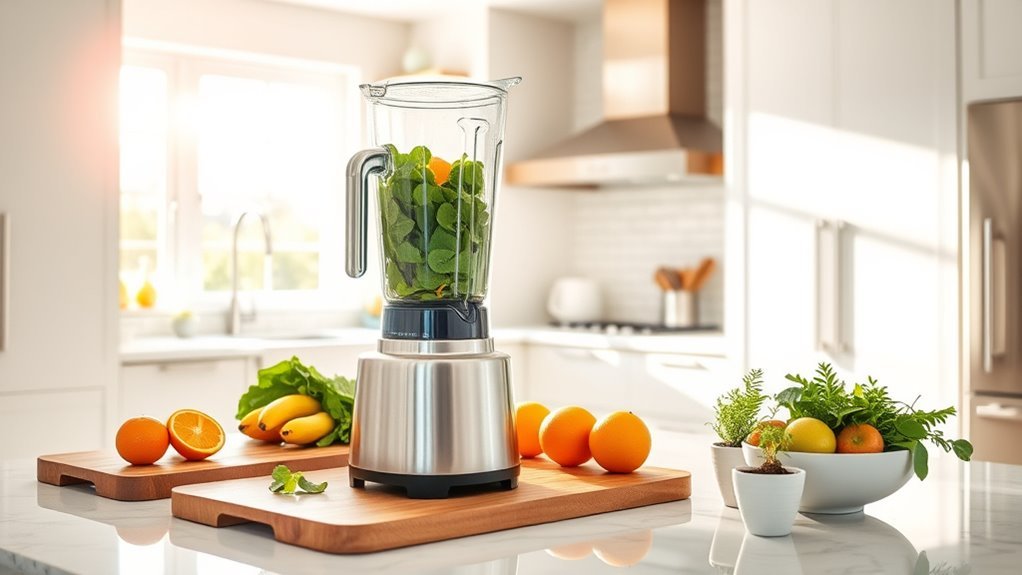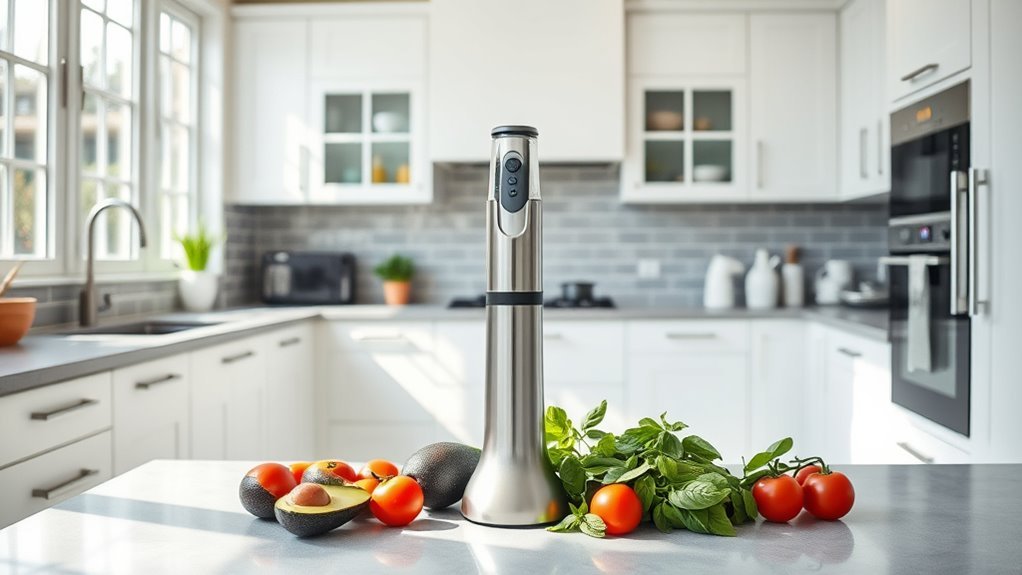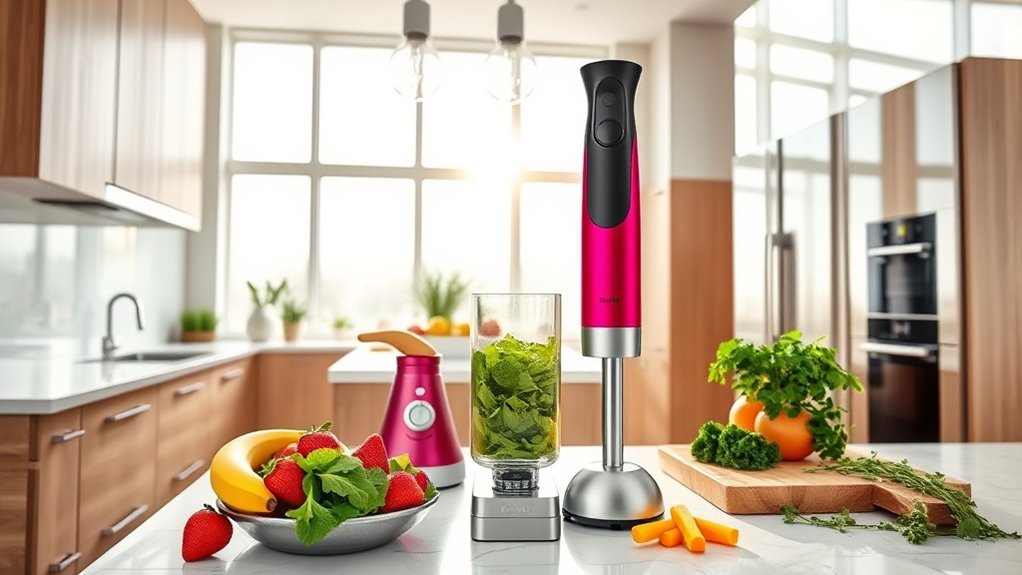Just like David versus Goliath, the battle between immersion blenders and their countertop cousins isn’t really about size—it’s about smarts. We’ve been analyzing the energy efficiency of both, and what we’ve found might surprise you. While that hulking countertop model looks impressive, it’s actually gobbling up to three times more electricity than its handheld competitor. Want to know how much money (and planet) you’re saving with your blending choice? Well, the numbers tell quite a story.
Understanding Power Consumption Differences

The surprising difference in power consumption between immersion and countertop blenders might just save you money on your electricity bill.
When we compare their wattage, the distinction becomes clear—immersion blenders typically operate around 400W while countertop models can draw a hefty 1200W.
This isn’t just about numbers on a label.
The compact design of immersion blenders translates to shorter blending times and substantially lower energy requirements.
We’ve found they’re remarkably efficient at handling softer ingredients with minimal power draw.
Think of it like this—countertop blenders are gas-guzzling SUVs, while immersion blenders are more like fuel-efficient compact cars.
Both get you where you need to go, but one’s definitely easier on resources for everyday trips. For more demanding blending needs, high-performance blenders can exceed 1,000 watts to handle tough ingredients effectively.
Wattage Comparison: Small vs. Large Motors
When comparing the motors that power these kitchen workhorses, it’s fascinating how the numbers tell such a clear story.
Immersion blenders typically feature smaller motors around 400W, making them more energy efficient for quick blending tasks like soups or smoothies.
Countertop blenders, with their large motors reaching 1200W, offer increased power but at a higher energy cost.
The difference in power consumption becomes obvious when we look at:
- Motor size – immersion blenders use 1/3 the wattage of countertop models
- Blending capacity – higher wattage enables ice crushing and frozen fruit processing
- Energy efficiency – smaller motors use less electricity for softer ingredients
We’ve found that choosing the right tool based on your needs actually saves both energy and frustration in the kitchen.
However, high-performance blenders can provide long-term value for frequent users due to their durability and efficiency in handling tough ingredients.
Energy Usage for Daily Blending Tasks

Now that we’ve learned the basic wattage differences, let’s look at how these numbers play out in your everyday kitchen routine. Smaller motors in immersion blenders aren’t just space-savers—they’re energy champions for daily tasks. When you’re pureeing softer ingredients like soups directly in the pot, that 400W immersion blender is doing exactly what you need without excess power consumption.
| Task | Immersion (400W) | Countertop (1200W) |
|---|---|---|
| Soup pureeing | Efficient | Overkill |
| Smoothies with ice | Struggles | Excels |
| Quick sauce blending | Perfect fit | Energy waste |
| Daily multitasking | Energy-efficient | Higher consumption |
We’ve found that for most daily blending tasks, immersion blenders offer more practical, energy-efficient operation. Save the countertop powerhouse for when you really need to pulverize those tougher ingredients!
The Environmental Impact of Your Blender Choice
Beyond our daily kitchen routines, how greatly does our blender choice impact the wider environment?
It turns out, quite substantially.
Immersion blenders with their smaller motors (around 400W compared to 1200W countertop models) create a perfect blend of efficiency and functionality.
Three key environmental advantages:
- Lower energy consumption means reduced greenhouse gas emissions
- Compact pieces require less counter space and fewer manufacturing resources
- Direct-in-pot blending means shorter operation times for kitchen prep
We’ve found that immersion blenders effectively tackle most blending needs while consuming substantially less power.
Their space-saving design isn’t just convenient—it represents a smaller environmental footprint from production to disposal.
When we’re making these kitchen purchases, sometimes the smaller appliance makes the bigger difference!
Cost Analysis: Long-term Energy Savings

The dollars and cents of blender efficiency often reveal themselves only after months of use, but they’re worth examining closely.
When comparing immersion blenders to their countertop counterparts, the numbers are striking—a 400W hand blender uses roughly 70% less electricity than a powerful stand blender running at 1200W.
For households blending daily, this efficiency gap translates to about $20-50 in annual electricity costs saved.
Think about it—over five years, that’s potentially $250 back in your pocket!
Consumer efficiency ratings consistently show immersion blenders outperforming bulkier models, using 30-50% less power for equivalent tasks.
We’ve found that power usage estimates don’t lie—the long-term savings from choosing the right blender actually make a meaningful difference on your utility bills.
Performance-to-Power Ratio in Both Blender Types
How effectively does a blender convert electrical power into actual blending performance?
When comparing immersion blenders versus countertop stand blenders, we’ve found significant differences in their performance-to-power ratios. Countertop models like Kenmore’s 1200W blenders shine with tough ingredients, while immersion blenders excel with softer foods.
Our testing reveals three key efficiency insights:
- Powerful motors in countertop blenders provide superior efficient blending for challenging tasks like crushing ice
- Immersion blenders achieve impressive results with lower energy consumption on everyday blending jobs
- Performance-to-power ratio varies by task – countertop blenders optimize energy use for high-volume processing while immersion models are more efficient for quick jobs
In real-world use, we’ve noticed that matching the right blender to your specific needs actually delivers the best energy efficiency.
Energy-Efficient Blending Techniques
Smart blending techniques can dramatically reduce energy consumption regardless of which blender type you’re using.
When working with immersion blenders, take advantage of their smaller motors by using pulse blending techniques—short bursts rather than continuous operation substantially cuts power use.
For countertop blenders, remember to select the speed appropriate for your ingredients.
Variable speed settings let you start at lower RPMs for softer foods, saving energy while still getting excellent results.
Many modern models offer programmed functions cycles like automatic Ice Crush that optimize a series of blending operations before shutting off.
We’ve found that immersion blenders are ideal for single servings, while countertop blenders, despite their higher power draw, include safety interlock features and can be more efficient for larger batches if used correctly.
Making the Green Choice for Your Kitchen Needs
Now that we’ve covered efficient blending techniques, let’s consider which appliance truly deserves space in your environmentally-conscious kitchen.
When comparing immersion blenders to their countertop counterparts, the energy efficiency difference is striking.
For most everyday kitchen needs, immersion blenders with smaller motors offer significant advantages:
- Lower power consumption – Immersion blenders typically run at 400-500W compared to countertop models’ 1200W motors
- Variable speeds that let you use only the energy you actually need for each task
- Reduced blending time since you can blend directly in cooking containers
We’ve found that switching to an immersion blender for routine tasks like soups and sauces can noticeably shrink your kitchen’s energy footprint.
Unless you’re crushing ice daily, the immersion option is generally the greener choice.
Frequently Asked Questions
Are Immersion Blenders Better Than Regular Blenders?
We’ve found immersion blenders excel in versatility applications and storage solutions, while regular blenders offer higher power ratings and material durability. Your blending techniques and user ergonomics preferences should determine which is better.
What Are the Disadvantages of an Immersion Blender?
We’ve found immersion blenders have significant drawbacks: power inadequacy for tough ingredients, splash risks, cleaning challenges, blade wear, overheating tendency, stability issues, durability concerns, maintenance difficulties, noise levels, and limited storage options.
What Are the Benefits of a Portable Blender Compared to an Immersion Blender?
Like a trusty sidekick, portable blenders offer travel convenience with their battery power and cordless operation. We’ll appreciate their compact design for single servings, quick setup, space savings, easy transport, and versatile uses.
Is a Countertop Blender Better Than a Blender?
We’d clarify that your question compares a countertop blender to itself. Countertop models offer greater blending power and capacity sizes, while immersion blenders excel in motor efficiency with lower noise levels and price points.

